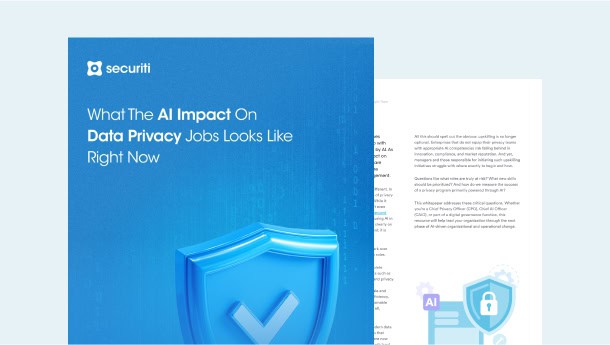In today’s digital age, individuals (data subjects) have more control over their personal data than ever, owing to the enactment of data privacy laws such as the European Union’s General Data Protection Regulation (GDPR) and the California Consumer Privacy Act (CCPA) now amended by the California Privacy Rights Act (CPRA) in the United States.
A key aspect of this increased transparency is the ability of individuals to request organizations (data controllers) about any personal data the organization may have about the individual via a Data Subject Request (DSR). However, honoring DSRs can be complex and time-consuming for many organizations, especially those that handle large volumes of personal data.
This guide delves into the world of DSRs and explores the cost of handling DSRs manually and automatically. Organizations must grasp the whole cost of handling DSRs to navigate the constantly evolving data privacy landscape efficiently and avoid non-compliance penalties.
Learn all about Data Subject Access Request (DSAR).
Empowering Data Subjects: Unpacking the Importance of DSRs
The first step is to understand the relevance of DSRs before delving into the cost of handling them. A DSR is a formal query request made by a data subject to an organization, intending to access/be informed/rectify/delete/forget/restrict processing/data portability/object to processing/object to automated decision making/withdraw consent of the personal data that the organization holds about them. As per the applicable laws, organizations must legally respond to these DSRs as soon as possible, usually within 30 to 45 days.
Learn how to manage DSARs under CCPA efficiently and effectively.
Manual DSR Handling: The Legacy Approach
Ever since the inception of data privacy laws, organizations have resorted to manually handling DSRs. Manually handling DSRs involves dedicated personnel who manually collect and review multiple documents, emails, and databases to extract the requested data.
Although manually handling DSRs can work well for small-scale organizations, it gets more costly and time-consuming for organizations handling a high volume of DSRs. The costs of manually handling DSRs outweigh the efficiency gains when employing automated processes. Typically, manual processes are:
Resource Intensive
Handling DSR manually involves a lot of human involvement and wastes valuable time for employees that could have been dedicated to handling an organization’s other critical tasks. It also increases an organization’s expenses by adding or reassigning specialized employees and training them to meet the increased demands of DSR processing.
Error-Prone
Humans have long been the weakest link in the cybersecurity chain. Human processes are error-prone, such as unintentional oversight, data discrepancies, or partial responses. Due to the potential penalty for violating data protection laws, human errors may jeopardize one's reputation and the legal standing of an organization.
Time-Consuming
Manual DSR processing takes a lot of time, and when there are a lot of DSRs, it can cause response times to be delayed and possibly exceed deadlines set by applicable regulations.
Lack of Scalability
With DSR volumes increasing daily, manual processes can no longer meet the increased demand nor have scalable resources/processes to respond to DSRs swiftly.
Learn how to handle DSARs from employees & ex-employees.
Automated DSR Handling: Modern, Efficient and Cost-Effective Approach
To manage DSRs, numerous organizations are resorting to automated solutions due to the widespread availability of digital tools and the increasing recognition of the significance of DSRs. Automation can streamline the entire process, making it faster, more accurate, and cost-effective. The benefits of automated DSR handling include:
Efficient Process
Automation accelerates the DSR response process by swiftly identifying and collating relevant data belonging to an individual from various sources.
Ensures Accuracy
Automated systems significantly reduce the possibility of errors by ensuring a uniform approach to handling DSRs, reducing the risk of errors, inconsistencies, and potential compliance issues. Additionally, they ensure that all needed data is correctly collected and accurately reported.
Cost-Effective
Implementing automation requires an upfront investment but comes packed with significant long-term cost benefits, such as fewer expenses resulting from the requirement for fewer man-hours.
Agile and Scalable
Automated DSR solutions are designed to handle large volumes of DSRs, making them an ideal option for organizations that actively engage in responding to DSRs. Even if an organization isn't receiving a lot of DSRs right now, it might start receiving a lot in the future. DSR automation will become necessary without the need for proportionally increasing resources.
Audit Trails
Automation provides detailed audit trails, which are beneficial for transparency and compliance since they demonstrate how DSRs were handled correctly.
Data Security
Enforcing data security policies through automated processes can help secure sensitive personal data from data breaches or unauthorized access.
Compliance
Automation significantly reduces the possibility of legal ramifications by ensuring that responses are consistent and comply with applicable data protection regulations.
Conclusion
Modern data protection laws heavily hinge on DSRs, yet managing them accurately and efficiently is an enormous challenge for organizations. Although managing DSR manually can be efficient for small-scale operations, the amount of work involved increases with the volume of requests. In contrast, automated DSR handling provides a more scalable, accurate, and efficient approach.
Organizations that invest in effective DSR automation tools will be better positioned to meet the increasing demands of a data-conscious world while upholding compliance and confidence with their data subjects as data privacy requirements continue to evolve.
An organization may spend between $1,400 and $10,000 on manual DSR processing for each DSR, depending on the complexity of its organization. Despite this, several companies are not configured to handle DSRs profitably.
Adopting DSR automation is the most efficient and modern way to honor DSRs. It enables organizations to save significant financial resources during the DSR process, lower the risk of compliance fines, and maintain brand integrity.
Request a demo to witness Securiti in action.








































